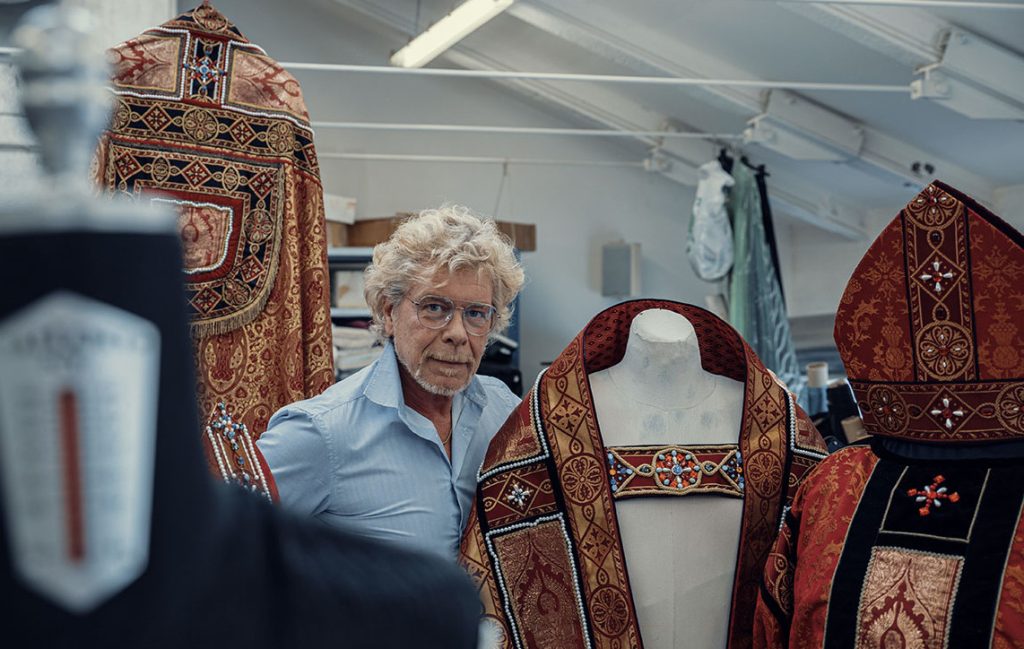

There is a place in Venice where it is possible to travel through time: Stefano Nicolao accompanies us in his historic atelier, in search of the very roots of Carnival, the city festival par excellence.
Stefano Nicolao is a costume historian – he holds classes at the Fine Arts Academy – and is an expert on the Venice Carnival. His atelier created many of the most beautiful historical costumes ever to be seen at the Mardi Gras parades. His passion and his knowledge of Venice made him, over the years, the go-to professional for anyone’s needs in terms of costumes, masks, and more. Many international film productions made use of Nicolao’s costumes. The amazing Atelier Nicolao is a time machine of fashion, offering complete period costumes – from underwear to wigs, hats, and shoes – and is a workshop where creativity and ingeniousness mix with excellent craft and teamwork.
How did the Venice Carnival change over the years?
A turning point for the Venetian Carnival were the late 1970s-early 1980s. The key figure, at the time, was Maurizio Scaparro, who single-handedly worked on the rebirth of this amazing festival, which is cultural and popular at once. Scaparro authored authentic Carnival shows, which inspired everyone to party and anticipate the days that would make the identity of Venice known to the world. At the centre of it all was a popular desire to don a costume and adopt, however briefly, a second identity, which is to say the pure and simple essence of Carnival. Ever since, it has been about enthusiasm every year, with the organization growing more complex and also more commercial, with art director Davide Rampello in the early 1990s. In those years, package deals were popular with tourists and included travel to Venice, one hotel night, and the ticket to one carnival party. This meant something for us costume-makers, too: demand focused on the higher end of the spectrum: everybody wanted to be a prince, princess, or the like. The fun of it, which included jokingly underplaying one’s own social class, has been lost. Today, fairy tale it is for everyone: be a prince or princess for a few hours, don extravagant costumes, and dream for a day. We must remember that the reborn Carnival started off with Venetian families making their own costumes, and Venetian have their own sense of desecrating humour – little room for pomp or splendour.
You opened your atelier in 1980
One of the reasons I decided to open shop in Venice was to have a place to work on the growing demand for costumes. I wanted my shop to become a point of reference for show business, and counter the offer that, so far, had been that of theatre dressmakers in Rome and Milan. My shop is also different, in that it focuses on the history of Venice and employs traditional materials that would be difficult to market elsewhere. Over the years, my sources of inspiration have always been Venetian art, especially painting: from the 1700s, to the years of Austrian rule, to the mid-1900s. How did costumes change? As of late, attention shifted from originality to theatrical impact. There are famous photographs from Reuters that show what are commonly understood as being typical Venetian costumes, but it needs to be said that those ones have no footing in history. They look more like big scaffoldings than anything else, and can barely fit in the narrow alleys of Venice. In fact, they must be assembled in Piazza San Marco, and cannot really move from there. When I work with film or TV, that’s what directors want. Arguably, such big and unwieldy costumes take the role that elsewhere belongs to carnival floats.

Your upcoming ball at Palazzo Labia: Venice Reflections
I wanted the ball to evoke what I think are the Venetian reflections par excellence: water and glass, a well as all transparencies that we see around us: the battlements at Ca’ d’Oro, the polychrome marble inlays at Palazzo Ducale… In the Middle Ages, gold was assumed to be the symbol of divine light, and it was used broadly in the background of altarpieces or in the representation of sacred scenes. Venice has this ability to reverberate light in a way that is unique. It is golden. It happened to each of us to be moved by the poignant games of light in definite moments of the day: some sunrises or sunsets know no equal.
A must for the 2023 Venice Carnival
There is no one single costume that you just have to wear. My heart will always have a place for the sonorous garment, a concept costume designed by Alessandro Mendini and Anna Gili for the Universal Expo at Osaka in 1985. It is a kind of oversized origami, made in shapes and with materials that make sound according to every motion of the body: the friction of cloth, metal, pendants, body, and floor make an array of different sounds. I met Mendini and Gili and worked with them to make their idea come true. At the time, they presented me with a scale model. I had my father build an aluminium frame for the costume, and I took care of the rest. It was such a challenge, such a foolish one, but we made it, and I will always think dearly of it. One thing I look forward to making, sometime in the future, is an optic fibre costume. In fact, I began working on some ideas, but it won’t be easy. For the opening parade at the 2023 Carnival, I designed a costume made of light for the Queen – a first step towards what I hope I will be able to make one day. Light will guide us forward after dark, difficult years, and I hope it will enlighten us all.
Ph. De Rigo Vision